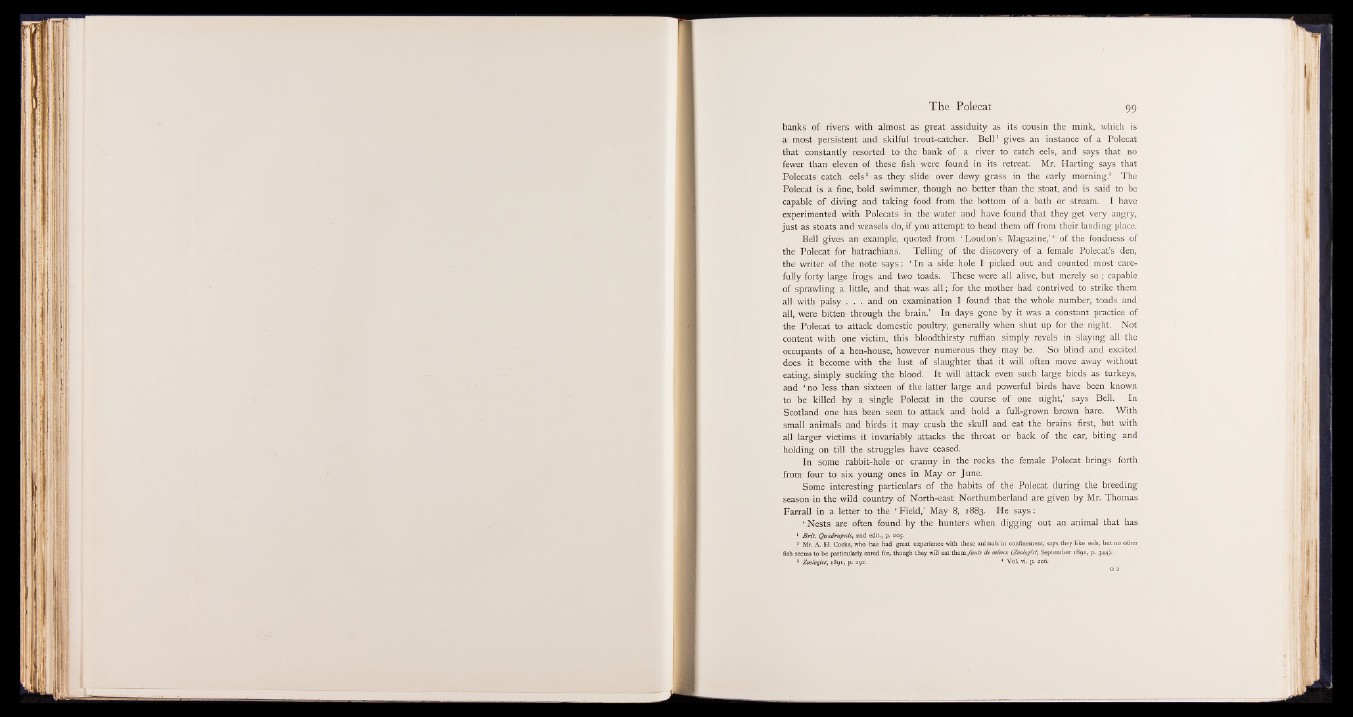
banks of rivers with almost as great assiduity as its cousin the mink, which is
a most persistent and skilful trout-catcher. B e ll1 gives an instance of a Polecat
that constantly resorted to the bank of a river to catch eels, and says that no
fewer than eleven of these fish were found in its retreat. Mr. Harting says that
Polecats catch eels2-as they slide over dewy grass in the early morning.8 The
Polecat is a fine, bold swimmer, though no better than the stoat, and is said to be
capable of diving and taking food from the bottom of a bath or stream. I have
experimented with Polecats in the water and have found that they get very angry,
just as stoats and weasels do, if you attempt to head them off from their landing place.
Bell gives an example, quoted from ‘ Loudon’s Magazine,’ 4 of the fondness of
the Polecat for batrachians. Telling of the discovery of a female Polecat’s den,
the writer of the note say s : ‘ In a side hole I picked out and counted most carefully
forty large frogs and two toads. These were all alive, but merely s o ; capable
of sprawling a little, and that was a ll; for the mother had contrived to strike them
all with palsy . . . and on examination I found that the whole number, toads and
all; were bitten through the brain;’ In days gone by it was a constant practice of
the Polecat to attack domestic poultry, generally when shut up for the night. Not
content with one victim, this bloodthirsty ruffian simply revels in slaying all the
occupants of a hen-house, however numerous they may be. So blind and excited
does it become with the lust of slaughter that it. will often move away without
eating, simply sucking the blood. It will attack even such large birds as turkeys,
and * no less than sixteen of the latter large and powerful birds have been known
to be killed by a single Polecat in the course of one night,’ says Bell. In
Scotland one has been seen to attack and hold a full-grown brown hare. With
small animals and birds; it may crush the skull and eat the brains first, but with
all larger victims it invariably attacks the throat or back of the ear, biting and
holding on till the struggles have ceased.
In some rabbit-hole or cranny in the rocks the female Polecat brings forth
from four to six young ones in May or June.
Some interesting particulars of the habits of the Polecat during the breeding
season in the wild country of North-east Northumberland are given by Mr. Thomas
Farrall in a letter to the ‘ Field,’ May 8, 1883. He says :
‘ Nests are often found by the hunters when digging out an animal that has
1 Brit. Quadrupeds, 2nd edit, p. 205.
2 Mr. A. H. Cocks, who has had great experience with these animals in confinement, says they like eels, but no other
fish seems to be particularly cared for, though they will eat them faute de mieux (Zoologist, September 1891, p. 344).
3 Zoologist, 1891, p. 292. * Vol. vi. p. 206.